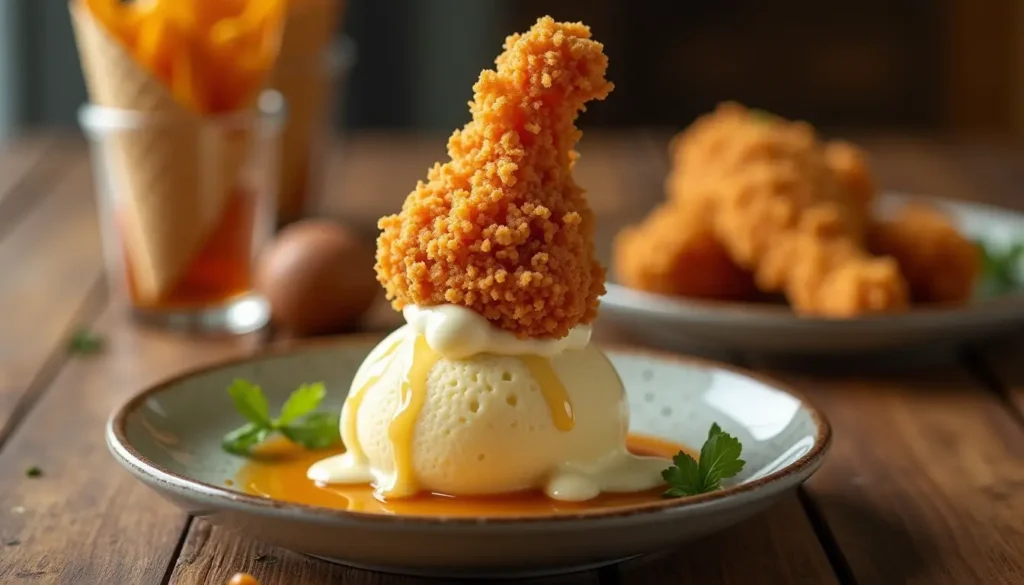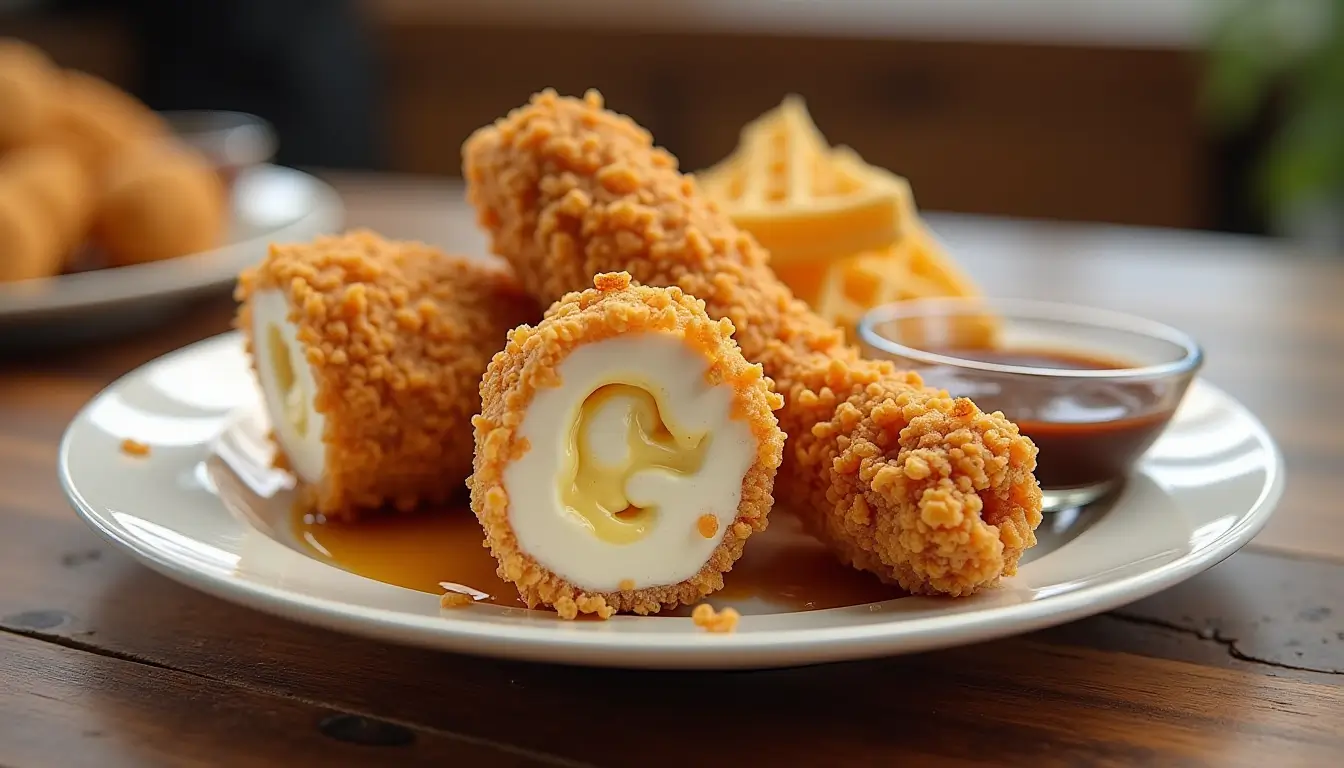Fried Chicken Ice Cream Magic: How to Make It Perfect
Picture this: You’re scrolling through social media when suddenly, a video stops you cold. Someone is actually eating fried chicken ice cream—and they’re loving every spoonful. Your first reaction? “That can’t be real.” Your second? “I need to try this immediately.”
Welcome to the wonderfully weird world of fried chicken ice cream, where savory meets sweet in ways that shouldn’t work but absolutely do. This isn’t just another viral food trend—it’s a culinary revolution that’s redefining what dessert can be.
You might be wondering if this is some elaborate internet hoax. Trust me, it’s not. Professional chefs and innovative home cooks worldwide are discovering that the marriage between crispy, seasoned chicken flavors and creamy frozen desserts creates something truly magical. This combination challenges everything you thought you knew about flavor pairing.
Whether you’re an adventurous home cook, a professional chef looking to surprise your customers, or simply someone who believes that the best flavors come from the most unexpected places, you’ve found your ultimate guide. We’re about to embark on a journey that will transform how you think about both dessert and innovation.
In this comprehensive exploration, we’ll dive deep into the science, artistry, and pure magic behind creating the perfect fried chicken ice cream. From understanding the flavor profiles that make this combination work to mastering the techniques that ensure every scoop is perfection, you’re about to discover why this trend is more than just a novelty—it’s the future of creative dessert making.
Chicken Ice Cream: How This Amazing Flavor Actually Works

The Science Behind Sweet and Savory Fusion
Understanding chicken ice cream requires diving into the fascinating world of flavor chemistry. When we think of chicken in frozen dessert form, we’re not talking about chunks of meat floating in vanilla—we’re discussing a sophisticated flavor profile that captures the essence of perfectly seasoned, crispy fried chicken.
Your taste buds are remarkably adaptable. They can distinguish between thousands of different flavor combinations, and they’re particularly drawn to umami—that savory, satisfying taste that makes foods like aged cheese, mushrooms, and yes, perfectly seasoned chicken so irresistible. When you translate this umami richness into ice cream form, something extraordinary happens.
The key lies in understanding how temperature affects flavor perception. Cold temperatures actually enhance certain taste compounds while muting others. This means that the herbs and spices you associate with fried chicken—rosemary, thyme, garlic, paprika—become more pronounced and complex when frozen, creating layers of flavor that unfold as the ice cream melts on your tongue.
Flavor Profile Breakdown
Creating authentic chicken ice cream starts with deconstructing what makes fried chicken so appealing. It’s not just the meat—it’s the entire sensory experience.
Umami Foundation: The savory depth that makes chicken ice cream memorable comes from carefully extracted chicken essence. This isn’t about adding actual chicken to your ice cream base (though some adventurous chefs do create chicken fat infusions). Instead, it’s about capturing the aromatic compounds that make your mouth water when you smell perfectly seasoned fried chicken.
Herb and Spice Integration: The magic happens when you understand how different seasonings behave in frozen form. Rosemary becomes more piney and aromatic. Thyme takes on an earthier, more complex character. Garlic transforms from sharp and pungent to mellow and sweet. These flavor transformations are what make chicken ice cream work so beautifully.
Texture Considerations: Creating the “fried” sensation without actual frying requires creativity. Some makers incorporate tiny pieces of seasoned breadcrumbs or use textural elements like candied herbs to mimic the satisfying crunch of fried chicken coating.
Base Development Techniques
Your success with chicken ice cream depends heavily on your approach to flavor development. Here are the proven methods that professional ice cream makers use:
Infusion Methods: The most effective technique involves creating concentrated flavor extracts. You can steep herb and spice blends in warm cream (not hot enough to cook, but warm enough to extract flavors), then strain and chill the mixture. This process typically takes 2-4 hours and requires careful temperature control to prevent curdling.
Emulsification Secrets: Achieving smooth texture with savory elements requires understanding how oils and fats behave in frozen desserts. If you’re working with chicken fat (yes, some recipes call for it), you’ll need to ensure proper emulsification to prevent separation. Lecithin can be your friend here, helping to bind fat and water molecules for a smoother final product.
Stabilizer Selection: Choose your stabilizers carefully. Guar gum and xanthan gum work well for maintaining texture, but they can also mute delicate flavors. Start with smaller amounts and adjust based on your specific recipe requirements.
Common Challenges and Solutions
Working with chicken ice cream presents unique challenges that you won’t encounter with traditional flavors:
Over-Seasoning: It’s tempting to add more spices to make the chicken flavor more prominent, but this often backfires. Cold temperatures dull some flavors while amplifying others. What tastes balanced at room temperature might be overwhelming when frozen.
Texture Issues: Incorporating savory elements can affect ice cream texture. Proteins from chicken extracts can create graininess if not properly handled. Always strain your infusions thoroughly and consider using a fine mesh strainer or even cheesecloth for the smoothest results.
Flavor Masking: Sometimes the dairy base can mask subtle savory notes. Combat this by using a lighter base or by adding flavor compounds at different stages of the churning process.
Ice Cream Chicken: How This Amazing Combo Actually Works

Mastering the Art of Frozen Poultry Perfection
The concept of ice cream chicken goes beyond simple flavor—it’s about creating a complete sensory experience that honors both the comfort of fried chicken and the joy of premium ice cream. This approach requires technical mastery that bridges the gap between traditional ice cream making and innovative flavor development.
When you think about ice cream chicken, you’re essentially reverse-engineering the fried chicken experience. Instead of starting with chicken and adding flavors, you’re starting with a frozen dessert foundation and building chicken-inspired elements into it. This requires a completely different mindset and approach.
Ingredient Sourcing and Preparation
Premium Base Selection: Your choice of dairy foundation significantly impacts the final product. Heavy cream provides richness that complements savory flavors, while half-and-half creates a lighter base that allows delicate chicken notes to shine through. Some makers experiment with buttermilk bases, which add tangy complexity that pairs beautifully with herb seasonings.
Seasoning Blend Creation: Building complex flavor layers requires understanding how different spices interact when frozen. Start with classic fried chicken seasonings—salt, black pepper, paprika, garlic powder, onion powder—then add complexity with herbs like thyme, rosemary, and sage. Each spice behaves differently in frozen form, so extensive testing is essential.
Extract vs. Whole Ingredient: Deciding when to use extracts versus whole ingredients depends on your desired flavor intensity and texture goals. Extracts provide clean, concentrated flavors without affecting texture, while whole ingredients (like fresh herbs) add visual appeal and textural interest but can create processing challenges.
Advanced Preparation Techniques
Cold Infusion Methods: Unlike traditional hot infusions, cold extraction preserves delicate flavor compounds that might be destroyed by heat. This process takes longer—sometimes 8-12 hours—but results in cleaner, more complex flavors. You can accelerate cold infusion using ultrasonic baths or specialized extraction equipment.
Texture Enhancement Strategies: Creating satisfying mouthfeel requires balancing creaminess with textural elements that remind you of fried chicken. Some makers incorporate freeze-dried chicken skin powder (yes, it exists) or use specialized protein powders that add umami depth without grittiness.
Flavor Timing: When to add each component during churning affects final flavor balance. Delicate herbs should be added early in the process, while more robust spices can be incorporated later. Fat-soluble compounds need time to properly integrate, while water-soluble elements can be added near the end of churning.
Professional vs. Home Kitchen Considerations
Making ice cream chicken at home requires adapting professional techniques to standard equipment:
Temperature Control: Professional kitchens have precise temperature control systems. At home, you’ll need to monitor temperatures carefully using digital thermometers and adjust timing based on your equipment’s capabilities.
Scaling Recipes: Professional recipes often call for ingredients that aren’t readily available to home cooks. Learn to substitute commercial stabilizers with gelatin or agar, and adapt extraction techniques for smaller batches.
Equipment Limitations: Home ice cream makers have different churning capabilities than commercial machines. This affects texture development and incorporation of textural elements. Adjust your recipes accordingly and be prepared for longer processing times.
Quality Control and Food Safety
Working with chicken-inspired flavors requires additional attention to food safety:
Sanitation Protocols: While you’re not working with raw chicken, the herbs and spices you use can harbor bacteria. Always use fresh, high-quality ingredients and maintain proper sanitation throughout the process.
Storage Considerations: Savory ice creams can be more susceptible to flavor degradation than sweet varieties. Store in airtight containers and consume within recommended timeframes to maintain optimal flavor and safety.
Not Fried Chicken Ice Cream: How to Choose Better Options

Navigating the World of Alternative Chicken-Inspired Frozen Desserts
Sometimes the journey to perfect fried chicken ice cream leads us to discover that not fried chicken ice cream might be exactly what we’re looking for. This isn’t about abandoning the concept—it’s about expanding your understanding of what chicken-inspired frozen desserts can be.
The beauty of exploring alternatives lies in discovering flavor profiles that might better suit your palate, your equipment limitations, or your target audience. Not everyone is ready for the full intensity of fried chicken ice cream, and that’s perfectly fine. The alternatives we’ll explore can serve as stepping stones or standalone achievements in their own right.
Alternative Flavor Profiles
Roasted Chicken Ice Cream: This approach delivers deeper, more complex savory notes without the intensity of fried chicken seasonings. Roasted chicken flavors tend to be more mellow and earthy, making them more approachable for hesitant tasters. The flavor development process focuses on herbs like rosemary and thyme, with subtle garlic undertones that complement rather than compete with the dairy base.
Grilled Chicken Variations: Smoky undertones and char essence create a completely different flavor experience. These variations often incorporate liquid smoke or use smoking techniques during the infusion process. The result is ice cream that captures the essence of backyard barbecues and summer gatherings.
Herb-Crusted Chicken: Fresh herb integration techniques allow you to highlight specific flavor notes. Basil, oregano, and Mediterranean herbs create bright, fresh flavors that work beautifully in frozen form. These variations often appeal to those who enjoy herb-forward dishes but aren’t ready for full savory ice cream.
International Chicken Flavors: Global seasoning approaches open up endless possibilities. Consider tandoori chicken ice cream with warm spices like cumin and coriander, or explore Asian-inspired versions with ginger, soy, and sesame notes. Each cultural approach brings unique flavor profiles that can transform your understanding of what chicken ice cream can be.
Decision-Making Framework
Audience Preferences: Understanding your target consumer is crucial. Are you making this for adventurous food lovers who embrace unusual flavors, or for a more mainstream audience that needs gentle introduction to savory desserts? Your audience should guide your flavor intensity and presentation decisions.
Production Constraints: Working within equipment limitations often leads to creative solutions. If your ice cream maker struggles with complex textures, focus on smooth, extract-based flavors. If you have limited access to specialty ingredients, explore how common seasonings can be combined in innovative ways.
Flavor Balance Considerations: Sometimes savory flavors can overwhelm sweet elements, creating an unbalanced final product. Alternative approaches often provide better balance for those who want chicken essence without complete abandonment of dessert expectations.
Seasonal Adaptations
Spring Profiles: Light, herb-forward flavors that celebrate fresh growth and renewal. Think chicken ice cream with fresh chives, dill, and light lemon notes.
Summer Variations: Grilled and barbecue-inspired flavors that capture outdoor cooking experiences. These often incorporate smokiness and char elements that pair beautifully with warm weather.
Fall Approaches: Richer, more complex flavors that complement autumn comfort foods. Roasted chicken with sage and thyme creates warmth and satisfaction.
Winter Adaptations: Hearty, warming flavors that provide comfort during cold months. These might incorporate warming spices or richer, more indulgent bases.
Common Pitfalls to Avoid
Over-Seasoning Warning Signs: When alternative flavors become too intense, they lose their appeal. Watch for signs like lingering aftertastes, overwhelming spice heat, or flavors that compete rather than complement each other.
Texture Issues: Alternative preparations can create unique texture challenges. Herb particles might create grittiness, while certain protein additions can cause crystallization problems.
Flavor Masking Problems: Sometimes attempts to create milder versions result in flavors that are too subtle to detect. Finding the right balance requires extensive testing and adjustment.
Frequently Asked Questions About Fried Chicken Ice Cream
Your Top Questions Answered
Q: Is fried chicken ice cream actually safe to eat?
A: Absolutely! When made properly, fried chicken ice cream uses flavor extracts and seasoning blends rather than actual raw chicken. The process involves creating chicken-flavored infusions that are completely safe for frozen dessert consumption. Professional food safety protocols ensure that any chicken-derived ingredients are properly processed and safe.
Q: How do you make fried chicken ice cream at home without special equipment?
A: You can create fried chicken ice cream using a standard ice cream maker by focusing on flavor infusion techniques. The key is developing a strong seasoning blend that captures the essence of fried chicken without requiring professional equipment. Start with herb and spice infusions in your cream base, strain thoroughly, and follow standard ice cream making procedures.
Q: What does fried chicken ice cream taste like?
A: Quality fried chicken ice cream delivers a surprising harmony of savory herbs, subtle chicken essence, and creamy sweetness. The flavor is more sophisticated than shocking—think of it as a savory ice cream with familiar comfort food notes. The initial taste is creamy and cool, followed by waves of herbs and spices that remind you of perfectly seasoned fried chicken.
Q: Can you make chicken ice cream variations for different dietary needs?
A: Yes! Chicken ice cream can be adapted for various dietary requirements including dairy-free, sugar-free, and even vegan versions using plant-based alternatives and creative seasoning approaches. Coconut milk bases work particularly well for dairy-free versions, while sugar alternatives can accommodate diabetic dietary needs.
Q: Where can I buy fried chicken ice cream if I don’t want to make it myself?
A: While still emerging, several artisanal ice cream shops and specialty dessert companies now offer fried chicken ice cream. Check local gourmet ice cream shops or specialty food stores in metropolitan areas. Many craft ice cream makers are experimenting with savory flavors and may offer limited-time chicken varieties.
Conclusion: Your Journey to Fried Chicken Ice Cream Mastery
The world of fried chicken ice cream isn’t just about creating a viral dessert—it’s about pushing culinary boundaries and discovering that the most unexpected combinations can create the most memorable experiences. You’ve now explored the science behind why this combination works, learned the technical skills needed to execute it properly, and discovered alternatives that might better suit your needs or preferences.
Remember, the best fried chicken ice cream comes from understanding both the science and the art behind flavor development. Start with quality ingredients, respect the process, and don’t be afraid to experiment. Your perfect scoop is waiting to be created, and the journey of discovery is just as rewarding as the destination.
The techniques you’ve learned here extend far beyond just chicken ice cream. You’ve gained insights into savory dessert creation, flavor development, and the creative process that drives culinary innovation. These skills will serve you well in all your future dessert adventures.
Whether you choose to master traditional fried chicken ice cream, explore alternative chicken-inspired flavors, or use these techniques to create entirely new savory dessert concepts, you’re now equipped with the knowledge and confidence to succeed.
Ready to start your fried chicken ice cream journey? Begin with small batches, keep detailed notes of your experiments, and most importantly, have fun with the process. The most innovative flavors often come from playful experimentation and willingness to embrace the unexpected.
Share your creations with friends and family—their reactions will be part of the joy. Document your process, celebrate your successes, and learn from any challenges you encounter. The world of savory ice cream is vast and full of possibilities, and you’re now prepared to explore it with confidence and creativity.
Your adventure in fried chicken ice cream mastery starts now. What will you create first?
Tried This Recipe? Tell Us How It Went!
There are no reviews yet. Be the first one to write one.

